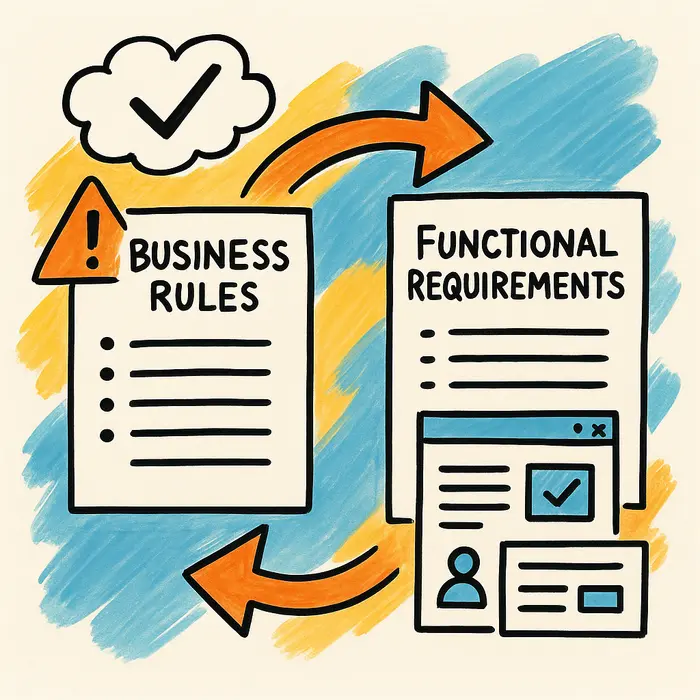When working on a project—whether it’s designing a new system, refining a process, or implementing software—confusion often arises around two essential elements: business rules and functional requirements. They sound similar, and sometimes they’re written together, but they serve very different purposes.
Understanding the distinction is critical for business analysts, project managers, and anyone tasked with turning ideas into working solutions.
Business Rules vs. Functional Requirements: At a Glance
| Aspect | Business Rules | Functional Requirements |
|---|---|---|
| What it describes | The constraints, policies, and conditions that govern business behavior | The system behaviors, features, and functions needed to meet business needs |
| Origin | Derived from laws, policies, standards, or company operations | Emerge from business rules, user needs, and system goals |
| Audience | Business stakeholders, compliance officers | Developers, designers, testers |
| Example | “Customers must be 18+ to open an account” | “The system shall validate customer age before account creation” |
What Are Business Rules?
Business rules are the non-negotiables of how a business operates. They describe conditions, constraints, or logic that guide or limit actions within a business process.
Characteristics of Business Rules:
Independent of technology or system implementation
Express constraints, calculations, or decision logic
Often stable and long-lasting
Can apply across departments, processes, or systems
Examples:
“Discounts over 20% require manager approval.”
“Invoices must be issued within 5 business days of delivery.”
“A loan cannot be approved if the applicant’s credit score is below 600.”
These rules help ensure consistency, compliance, and correctness across operations.
What Are Functional Requirements?
Functional requirements describe what a system or solution must do. They specify behaviors, interactions, or outputs that are needed to meet business needs—often as a response to business rules.
Characteristics of Functional Requirements:
Define system behavior and interaction
Are specific to software, tools, or processes
Guide developers, testers, and UX designers
May change as systems or user needs evolve
Examples:
“The system shall display an error message if a user under 18 tries to register.”
“When a user clicks ‘Submit Order,’ the system shall create a purchase record in the database.”
“The app shall send a confirmation email after payment is completed.”
They translate business needs and rules into executable actions.
Why the Distinction Matters
1. Clearer Communication
Mixing business rules into functional requirements muddies the waters. Business stakeholders might miss key policies buried in technical language. Developers might misinterpret what’s a system feature vs. a business constraint.
Better: Separate the “why” (business rule) from the “how” (functionality).
2. Better Change Management
Business rules change due to regulation, policy, or market shifts. If they’re baked into system logic without separation, updates become harder and riskier. By externalizing rules, you make systems more adaptable.
Example: If a rule changes from 18+ to 21+, updating just the rule logic is easier than modifying deep code.
3. Stronger Requirements Quality
Well-defined requirements support testability, traceability, and alignment with goals. When you clearly distinguish rules from functions, it’s easier to validate, test, and maintain both.
How to Define Each in Your Project
Step 1: Elicit Business Rules
Interview business stakeholders
Review policies, regulations, SOPs
Observe current operations and decisions
Ask: “What must always be true?”, “What can never happen?”, “What are the conditions for…?”
Tip: Use decision tables or rule catalogs to organize them.
Step 2: Define Functional Requirements
Use user stories, use cases, or process maps
Translate each business rule into the system behavior needed
Collaborate with developers and designers
Ask: “How will the system enforce or apply this rule?”
Tip: Use “The system shall…” statements to clarify functionality.
Example Breakdown: Putting It All Together
Let’s say you’re working on a loan application system.
Business Rules:
Applicants must be at least 21 years old.
Applicants with credit scores below 650 require manual review.
Only loans under $50,000 can be approved online.
Functional Requirements:
“The system shall prevent users under 21 from submitting the loan form.”
“The system shall flag applications with credit scores <650 for manual approval.”
“If loan amount > $50,000, the system shall redirect to a manual application process.”
Notice how each business rule informs one or more functional requirements.
Tips for Keeping Them Separate (and Aligned)
Maintain a rules catalog and a requirements document—link them via IDs.
Use decision tables to model complex logic and reference them in requirements.
Collaborate across roles—business, tech, QA—to ensure shared understanding.
Review together during sign-off to catch gaps or misinterpretations early.
Summary: Bridging the Gap Between Business and Tech
Clear requirements build strong systems—but clarity starts by knowing what kind of information you’re working with. Define your business rules, then build your functional requirements around them. That’s how you create solutions that are both effective and sustainable.
“Business rules guide behavior. Functional requirements enable it.”
